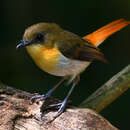Biology
(
anglais
)
fourni par Arkive
This shy, secretive bird is easily overlooked and little is known about its biology. Records do exist of this species foraging in dense tangled undergrowth in vines, rattan and climbing bamboo, rarely more than 10 metres from the ground (2). The diet is not well understood but, as its name suggests, the Palawan flycatcher is known to feed on insects and other small invertebrates (2) (4).
The breeding season is thought to last from May to at least September, possibly later, but no other information on this species' reproductive biology is available (2) (4).
Conservation
(
anglais
)
fourni par Arkive
In 1990, the whole of Palawan was designated a Biosphere Reserve, although enforcement of laws on habitat alteration and hunting has proven difficult. The Palawan flycatcher also occurs in St Paul's Subterranean River National Park, which is actively managed and protected by the local government of Palawan and may soon be significantly extended to the east (3).
Description
(
anglais
)
fourni par Arkive
This is a tiny, short-tailed flycatcher most often seen perching on low vines (3). The deep rufous-brown of the head and upperparts contrast with the bright chestnut colour of the tail and orange of the breast (2). This orange fades to a paler buff colour on the throat and into white on the lower breast and belly (3).
Habitat
(
anglais
)
fourni par Arkive
Found in lowland primary forest as well as some secondary growth up to at least 650 metres above sea level, and possibly up to 1,000 metres (2) (4). The Palawan flycatcher is believed to occupy the forest understorey up to 10 metres from the ground, with a preference for rattan and understorey palms, although it is possible that this small species has simply gone unobserved in the canopy (3) (4).
Range
(
anglais
)
fourni par Arkive
Endemic to Palawan and some of its satellite islands in the Philippines (3).
Status
(
anglais
)
fourni par Arkive
Classified as Vulnerable (VU) on the IUCN Red List 2007 (1).
Threats
(
anglais
)
fourni par Arkive
With such a small range that is being rapidly reduced by ongoing clearance, degradation and fragmentation of its lowland forest habitat, the Palawan flycatcher is considered vulnerable to extinction. Habitat destruction has been extensive on Palawan and logging and mining concessions have been granted for most remaining forest tracts on the island. Furthermore, illegal logging is thought to continue across much of the south of the island (3). However, the small populations on the tiny satellite islands of Pangulasian and Lagen appear relatively secure (3) (4).

